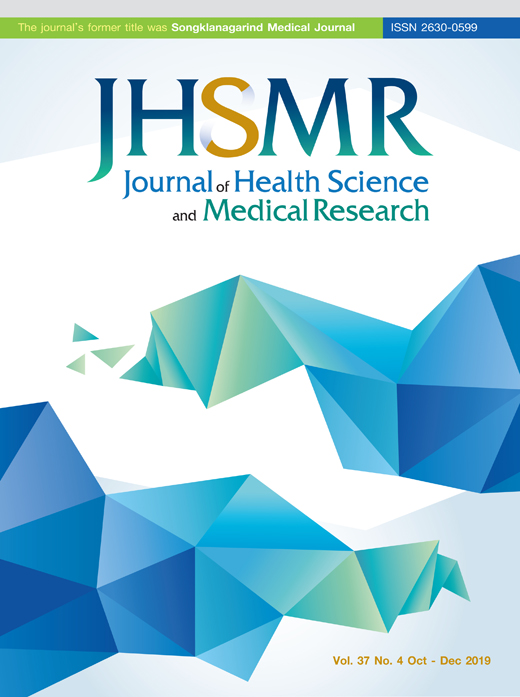Outcome of Transient Hypogastric Artery Balloon Occlusion with Cesarean Hysterectomy in Abnormal Adherent Placenta: Case Series
DOI:
https://doi.org/10.31584/jhsmr.201963Keywords:
adherent placenta, cesarean hysterectomy, hypogastric artery, transient balloon occlusionAbstract
Objective: To evaluate the outcome of pregnant women with abnormal placentation who underwent transient hypogastric artery balloon occlusion with cesarean hysterectomy.
Material and Methods: Descriptive retrospective study of patients with abnormal adherent placenta who underwent transient hypogastric artery balloon occlusion with cesarean hysterectomy between January 2014 and December 2016. Data were recorded and analyzed.
Results: Fourteen pregnant women with abnormal placentation were included in our series. Most patients underwent cesarean hysterectomy at less than 37 weeks of gestational age. The sonograms of 7 cases overestimated the severity of placenta adherence compared with the pathological diagnosis. The median estimated blood loss was 4,350 milliliters (mL). The median estimated blood loss in placenta accrete, increta and percreta were 3,000 mL, 5,337 mL and 5,150 mL, respectively. One case had a procedure-related complication: perforation of the small branch of the anterior division of the right hypogastric artery from the guidewire.
Conclusion: Intraoperative transient balloon occlusion of the hypogastric arteries was an effective method and safe treatment for controlling the massive intraoperative bleeding of cesarean hysterectomy. This technique can be an alternative option in combination with surgery in cases of abnormal placental adherence.
References
2. Silver RM, Landon MB, Rouse DJ, Leveno KJ, Spong CY, Thom EA. Maternal morbidity associated with multiple repeat cesarean deliveries. Obstet Gynecol 2006;107:1226-32.
3. Eller AG, Porter TF, Soisson P, Silver RM. Optimal management strategies for placenta accreta. BJOG 2009;116:648-54.
4. Bodner LJ, Nosher JL, Gribbin C, Siegel RL, Beale S, Scorza W. Balloon-assisted occlusion of the internal iliac arteries in patients with placenta accreta/percreta. Cardiovasc Intervent Radiol 2006;29:354-61.
5. Clark SL, Phelan JP, Yeh SY, Bruce SR, Paul RH. Hypogastric artery ligation for obstetric hemorrhage. Obstet Gynecol 1985; 66:353-6.
6. Evans S, McShane P. The efficacy of internal iliac artery ligation in obstetric hemorrhage. Surg Gynecol Obstet 1985;160:250-3.
7. Chait A, Moltz A, Nelson JH Jr. The collateral arterial circulation in the pelvis: an angiographic study. Am J Roentgenol Radium Ther Nucl Med 1968;102:392-400.
8. Royal College of Obstetricians and Gynaecologists, Royal College of Radiologists, British Society of Interventional Radiology. Good Practice No. 6: The role of emergency and elective interventional radiology in postpartum haemorrhage [monograph on the Internet]. London: RCOG, RCR, BSIR; 2007 [cited 2017 Apr 23]. Available from: https://www.rcog.org.uk/globalassets/documents/guidelines/goodpractice6roleemergency2007.pdf
9. Ballas J, Hull AD, Saenz C, Warshak CR, Roberts AC, Resnik RR, et al. Preoperative intravascular balloon catheters and surgical outcomes in pregnancies complicated by placenta accreta: a management paradox. Am J Obstet Gynecol 2012;207:216.e1-5.
10. Yi KW, Oh MJ, Seo TS, So KA, Paek YC, Kim HJ. Prophylactic hypogastric artery ballooning in a patient with complete placenta previa and increta. J Korean Med Sci 2010;25:651-5.
11. Darwish HS, Zaytoun HA. Kamel HA, Habash YH. Prophylactic preoperative balloon occlusion of hypogastric arteries in abnormal placentation; 5 years experience. Egypt J Radiol Nucl Med 2014;45:751-9.
12. Cali G, Forlani F, Giambanco L, Amico ML, Vallone M, Puccio G, et al. Prophylactic use of intravascular balloon catheters in women with placenta accreta, increta and percreta. Eur J Obstet Gynecol Reprod Biol 2014;179:36-41.
13. Tan CH, Tay KH, Sheah K, Kwek K, Wong K, Tan HK, et al. Perioperative endovascular internal iliac artery occlusion balloon placement in management of placenta accrete. AJR Am J Roentgenol 2007;189:1158-63.
14. Carnevale FC, Kondo MM, de Oliveira Sousa W Jr, Santos AB, da Motta Leal Filho JM, Moreira AM, et al. Perioperative temporary occlusion of the internal iliac arteries as prophylaxis in cesarean section at risk of hemorrhage in placenta accreta. Cardiovasc Intervent Radiol 2011;34:758-64.
15. Salim R, Chulski A, Romano S, Garmi G, Rudin M, Shalev E. Precesarean prophylactic balloon catheters for suspected placenta accreta: a randomized controlled trial. Obstet Gynecol 2015;126:1022-8.
16. Bishop S, Butler K, Monaghan S, Chan K, Murphy G, Edozien L. Multiple complications following the use of prophylactic internal iliac artery balloon catheterization in a patient with placenta percreta. Int J Obstet Anesth 2011;20:70-3.
17. Manalo EP, Barker AE. Histopathologic findings in human aortic media associated with pregnancy. Arch Pathol 1967;83:336-41.
18. Pagani G, Cali G, Acharya G, Trisch IT, Palacios-Jaraquemada J, Familiari A. et al. Diagnostic accuracy of ultrasound in detecting the severity of abnormally invasive placentation: a systematic review and meta-analysis. Acta Obstet Gynecol Scand 2018;97:25-37.
19. Philips J, Abuhamad A. Diagnosing placenta accreta spectrum with prenatal ultrasound. OBG Manag 2018;30:34-44.
20. Bowman ZS, Eller AG, Kennedy AM, Richards DS, Winter TC, Woodward PJ, et al. Accuracy of ultrasound for the prediction of placenta accreta. Am J Obstet Gynecol 2014;211:177.e1-7.
21. Rac MW, Moschos E, Wells CE, McIntire DD, Dashe JS, Twickler DM. Sonographic findings of morbidly adherent placenta in the first trimester. J Ultrasound Med 2016;35:263-9.
22. Kilcoyne A, Shenoy-Bhangle AS, Roberts DJ, Sisodia RC, Gervais DA, Lee SI. MRI of placenta accreta, placenta increta, and placenta percreta: pearls and pitfalls. AJR Am J Roentgenol 2017;208:214-21.
23. Miller DA, Chollet JA, Goodwin TM. Clinical risk factors for placenta previa-placenta accreta. Am J Obstet Gynecol 1997;177:210-4.
24. Chou MM, Kung HF, Hwang JI, Chen WC, Tseng JJ. Temporary prophylactic intravascular balloon occlusion of the common iliac arteries before cesarean hysterectomy for controlling operative blood loss in abnormal placentation. Taiwan J Obstet Gynecol 2015;54:493-8.
25. Sewell MF, Rosenblum D, Ehrenberg H. Arterial embolus during common iliac balloon catheterization at cesarean hysterectomy. Obstet Gynecol 2006;108:746-8.























